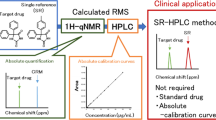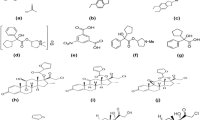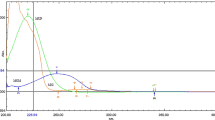Abstract
Cyclizine (CYZ) abuse is commonly reported, either through oral or intravenous routes, for its euphoric or hallucinatory effects. The concomitant misuse of CYZ among addicted teenagers leads to life-threatening neuromuscular disorders. Consequently, two green and validated chromatographic methods were developed for the determination of CYZ, an antiemetic drug, in its parenteral formulation in the presence of 1-methyl piperazine and diphenylmethanol (benzhydrol) as the pharmacopeial stated impurities of CYZ. The first method was TLC-densitometry that relied on using a mixture consisting of ethyl acetate:isopropanol:ammonia (9.5:1:0.5, by volume) as a developing system, TLC 60 F254 silica gel plates as a stationary phase and detection of the scanned bands was performed at 210.0 nm. On the other hand, the second method was UPLC which based on the separation of CYZ and its impurities using a mobile phase consisting of ethanol and acidic water at pH 5 adjusted by phosphoric acid in the ratio of (60:40, %v/v) at flow rate 0.2 mL min−1 and UV detection were carried out at 210.0 nm. The greenness profile of the established methods was evaluated and calculated for the first time for CYZ and its toxic impurities through different assessment tools like analytical eco-scale, analytical method volume intensity and greenness profile methods. Validation of the developed methods was carried out in accordance with the guidelines of the International Conference on Harmonization. The suggested methods were accurate, reliable, time and cost-saving. Therefore, they could be used in quantification of CYZ abuse and its toxic impurities in parenteral formulation for routine quality control. The results achieved by applying the suggested methods were statistically analyzed and compared with those given by reported one and no significant differences were obtained regarding both precision and accuracy.


Similar content being viewed by others
References
Sweetman SC (2009) Martindale—the complete drug reference, 36th edn, pp 574–575
Bassett KE, Schunk JE, Crouch BI (1996) Cyclizine abuse by teenagers in Utah. Am J Emerg Med 14(5):472–474
Bailey F, Davies A (2008) The misuse/abuse of antihistamine antiemetic medication (cyclizine) by cancer patients. Palliat Med 22:869–871
Arnestad M, Beate K, Eldor B, Stray-pedersen A, Bachs L, Karinen R (2014) Suicide due to cyclizine overdose. J Anal Toxicol 38:110–112
Ruben SM, Mclean PC, John Melville RMN (1989) Cyclizine abuse among a group of opiate dependents receiving methadone. Br J Addict 84:929–934
Scientific T (2019) Material safety data sheet of N-methylpiperazine, vol 4, pp 1–8
Scientific T (2019) Material safety data sheet of benzhydrol, vol 2, pp 1–7
British pharmacopoeia (2013) London: Medicines and healthcare products regulatory agency, Cyclizine, vol 1, p 749
Al-shaalan NH (2012) Extractive spectrophotometric assay of cyclizine in a pharmaceutical formulation and biological fluids. Saudi Pharm J 20(3):255–262
Habib NM, Abdelwhab NS, Abdelrahman MM, Ali NW (2016) Spectrophotometric methods for analysis of different dosage forms containing pyridoxine hydrochloride. Eur J Chem 7(1):30–36
Saad AS, Naguib IA, Draz ME, Zaazaa HE, Lashien AS (2018) Validated analytical methods for the determination of drugs used in the treatment of hyperemesis gravidarum in multiple formulations. J AOAC Int 101(2):427–436
Wolff K, Sanderson MJ, Hay AWM (1990) A rapid horizontal TLC method for detecting drugs of abuse. Ann Clin Biochem 27:482–488
Habib NM, Abdelrahman MM, Abdelwhab NS, Ali NW (2017) Validated chromatographic methods for the analysis of two binary mixtures containing pyridoxine hydrochloride. J AOAC Int 100(2):414–421
Walker RB (1995) HPLC analysis and Pharmacokinetics, pp 27–166
Walker R, Kanfer I (1987) High-performance liquid chromatographic analysis of cyclizine and its metabolite, norcyclizine in biological fluids using solid phase extraction. Chromatographia 24:287–290
Taylor P, Jalal IM, Sa SI, Yasin TA (1988) Determination of ergotamine tartarate and cyclizine hydrochloride in pharmaceutical tablets by reverse phase HPLC. Anal Lett 21(9):1561–1577
Packert B, Winifred J, Vella-brincat A, James E (2011) Quantification of cyclizine and norcyclizine in human plasma by liquid chromatography—tandem mass spectrometry (LC–MS/MS). J Chromatogr B 879(9–10):605–609
Mohammadi A, Kanfer I, Sewram V, Walker RB (2005) An LC–MS–MS method for the determination of cyclizine in human serum. J Chromatogr B 824:148–152
Mao Y, Carr PW (2001) Separation of selected basic pharmaceuticals by chromatography using thermally tuned tandem columns. Anal Chem 73(13):4478–4485
Devgun MS (1983) Detection and measurement of dipipanone-cyclizine preparation (Diconal) Using gas-liquid and high-performance liquid chromatography. In: Kaye S, Meier G (eds) Proceedings of the 9th international conference on alcohol, drugs and traffic safety. San Juan, Puerto Rico
Jonczyk A (1999) Determination of cyclizine hydrochloride, caffeine and ergotamine tartarate mixtures by high performance liquid chromatography (HPLC). Acta Pol Pharm Drug Res 56(3):183–185
Mohammadi A, Kanfer I, Walker RB (2004) A capillary zone electrophoresis (CZE) method for the determination of cyclizine hydrochloride in tablets and suppositories. J Pharm Biomed Anal 35:233–239
Rani S, Singh G (2016) Ion selective electrodes for potentiometric determination of cyclizine in its pharmaceutical dosage form. Asian J Pharm Sci Technol 6(2):120–126
Rahman N, Najmul S, Azmi H, Wu H (2006) The importance of impurity analysis in pharmaceutical products: an integrated approach. Accredit Qual Assur 11(April):69–74
(2005) Ich Harmonised tripartite guideline, validation of analytical procedures: text and methodology Q2(R1)
El-gindy A, Emara S, Mostafa A (2004) Spectrophotometric and LC determination of two binary mixtures containing antihistamins. Farm 59:713–722
Fayed AS, Boltia SA, Musaed A, Hegazy MA (2020) Selective quantitation of co-formulated ternary mixture in the presence of potential impurities by liquid chromatographic methods. J Pharm Biomed Anal 177:1–10
USP United States Pharmacopeia (2011) 29th edn
Dunn PJ (2012) The importance of green chemistry in process research and development. Chem Soc Rev 41(4):1452–1461
Mohamed HM, Lamie NT (2016) Analytical eco-scale for assessing the greenness of a developed RP-HPLC method used for simultaneous analysis of combined antihypertensive medications. DRUG Formul Clin Methods 99(5):1260–1265
Hartman R, Helmy R, Welch CJ (2011) Green chemistry analytical method volume intensity (AMVI): a green chemistry metric for HPLC methodology in the pharmaceutical industry. Green Chem 13:934–939
Tobiszewski M (2016) Analytical methods metrics for green analytical chemistry. Anal Methods 8:2993–2999
Keith LH, Gron LU, Young JL (2007) Green analytical methodologies. Chem Rev 107(6):2695–2708
Campbell MJM, Demetriou B (1980) Assay of procyclidine hydrochloride, cyclizine hydrochloride and diethylcarbamazine citrate in tablets using lon-responsive electrodes. Analyst 105:605–611
Funding
This work is not funded.
Author information
Authors and Affiliations
Corresponding author
Ethics declarations
Conflict of interest
The authors declare no conflict of interest.
Additional information
Publisher's Note
Springer Nature remains neutral with regard to jurisdictional claims in published maps and institutional affiliations.
Electronic supplementary material
Below is the link to the electronic supplementary material.
Rights and permissions
About this article
Cite this article
Abdelrahman, M.M., Fares, M.Y., Abdelwahab, N.S. et al. Ecofriendly Validated Chromatographic Methods for Quantitation of Cyclizine and Its Toxic Impurities in Its Parenteral Formulation. Chromatographia 84, 155–165 (2021). https://doi.org/10.1007/s10337-020-03985-x
Received:
Revised:
Accepted:
Published:
Issue Date:
DOI: https://doi.org/10.1007/s10337-020-03985-x




